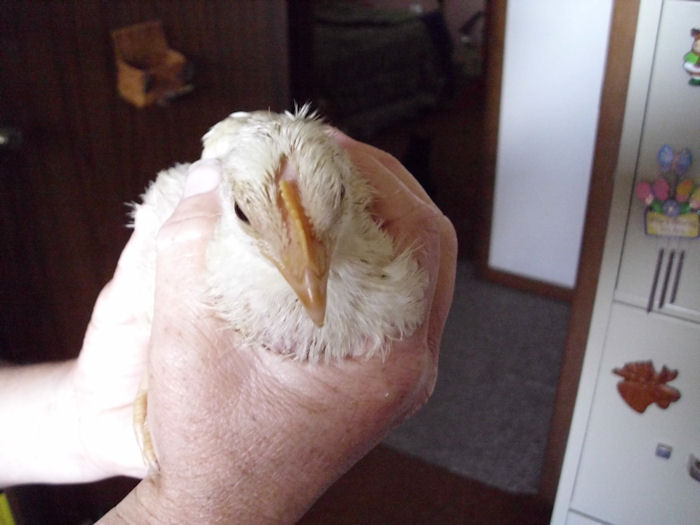You’ll remember from the Getting Started with Chickens post that we’re raising chickens this year. The chickens when the first five days with the heat lamp, after which we turned it off. After the first seven days, we started giving them food only during the first 12 hours of the day. In a factory setting, the chickens continually receive food, but we prefer that the chickens grow more slowly so they can develop strong bones and have a better survival rate. Of course, they get water whenever they want it.
Each morning now at 5:30, the young chickens wake up and immediately start chirping. Along with the birds outside our windows, it sounds a bit like “The Birds” or perhaps “Wild Kingdom.” There is no sleeping in our house after 5:30. All during the day the young chickens peck away at their food. Between 7:00 and 8:30 at night, the birds all nestle down and go to sleep.
Our chickens are growing slowly, but steadily. You remember that they were mere puffs of yellow at one point. Here’s how they look today (about five times the size they started):
Naturally, with all of this growth, the chickens need more space. They’re now in five boxes the same size of the original one. We can keep them in boxes for another week or two, but that’s about it. At that time, we’ll move them out to the chicken tractors, where each chicken will have two square feet of space in which to move about. That’s more space than you might imagine because they tend to clump together. You’ll hear more about the chicken tractors in my next post.
The young chickens are still eating chick starter, but they’ll move onto broiler mash soon. They’re also getting kitchen scraps and other more natural food (including bugs) now. We’re “hardening them off” at this point. What that means is that we dutifully take the boxes outside to a semi-shaded area each day. The chickens can hang out in the shade or move into the sun as desired. This stage helps the chickens adjust to the outdoors before we put them in the chicken tractors. If you suddenly move the chickens from an environment, such as your garage, to the outside, the shock could kill them.
Yes, you read correctly, we keep our chickens in the garage. One of our poultry farmer friends recommended the concept. It’s a wide-open space with an easy to clean floor. It could be the perfect place for you to raise your chickens too, with a bit of consideration. One of the biggest ones being the garage door, it can feel great to open that big door and watch the hens run out, it’s getting them back in that might be a problem. With the extra moisture and dirt generated from the chickens the door will also need more maintenance as well unless you’re keen on hiring your local garage door repair in Etobicoke that is. There is nothing more frustrating than a garage door that does not work properly after all. That farmer friend of ours recently had his garage doors repaired by a company that specializes in fixing local garage doors in Crownsville Maryland. He maintains his coop quite well, but it happened anyway. It’s just one of those that can occur, with or without chickens.
Each evening (about 4:00 or 5:00) we take them back into the garage for safety. At this point, they’re interesting enough that weasels, racoons, and even other birds would just love to have them for dinner. In fact, this is probably the most dangerous point in their growth because we still need to have them in the garage–just in case it gets cold (unlikely, but it can happen). Plus they’re still just a bit too small for the chicken tractors.
Heat is also a problem at this point. Young chicks require quite a bit of heat, but even they have limits. We’ve had a couple of extremely hot days and lost a couple of our charges due to the heat. Fans, time outside, and extra water just weren’t enough. The young chickens don’t need the heat of chicks anymore, but they haven’t developed fully enough to tolerate the heat swings of summer. So, you have to watch them carefully to ensure they’re staying comfortable.
We also lost a few of the chicks to other causes. One day the chicks managed to peck a hole in the box. We came home from town with more boxes, opened the garage door, and all the chicks came charging out. They looked quite determined to go on an adventure. So, we had to rush about gathering them up into the new boxes. It looked like one of those scenes you see on America’s Funniest Home Video, but this was real life. Unfortunately, we didn’t find all of them and other animals ate them.
We can tell that the young chickens are starting to make the transition between chicks and chickens. Their cheeps are becoming lower and a bit more like a cackle. No, it’s not the cackle of a chicken yet, but it’s getting there. They’re also starting to develop feathers. They haven’t quite gotten a case of the raging uglies yet, but they soon will as the hairy feathers they have now are replaced by a full set of real feathers. Let me know if you have any questions at [email protected].

